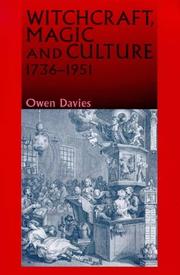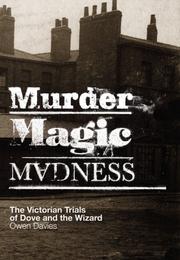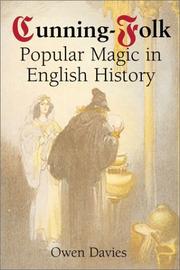| Listing 1 - 10 of 61 | << page >> |
Sort by
|
Book
ISBN: 9780199204519 0199204519 Year: 2009 Publisher: New York, N.Y. Oxford University Press
Abstract | Keywords | Export | Availability | Bookmark
 Loading...
Loading...Choose an application
- Reference Manager
- EndNote
- RefWorks (Direct export to RefWorks)
What is a grimoire? The word has a familiar ring to many people, particularly as a consequence of such popular television dramas as Buffy the Vampire Slayer and Charmed. But few people are sure exactly what it means. Put simply, grimoires are books of spells that were first recorded in the Ancient Middle East and which have developed and spread across much of the Western Hemisphere and beyond over the ensuing millennia. At their most benign, they contain charms and remedies for natural and supernatural ailments and advice on contacting spirits to help find treasures and protect from evil. But at their most sinister they provide instructions on how to manipulate people for corrupt purposes and, worst of all, to call up and make a pact with the Devil. Both types have proven remarkably resilient and adaptable and retain much of their relevance and fascination to this day. But the grimoire represents much more than just magic. To understand the history of grimoires is to understand the spread of Christianity, the development of early science, the cultural influence of the print revolution, the growth of literacy, the impact of colonialism, and the expansion of western cultures across the oceans. As this book richly demonstrates, the history of grimoires illuminates many of the most important developments in European history over the last two thousand years.
Book history --- Esoteric sciences --- Occultism --- Charms --- Charms in literature --- Magic in literature --- Occultisme --- Charmes --- Charmes en litérature --- Magie dans la litérature --- History. --- Dictionaries --- Histoire --- Dictionnaires anglais --- 133.4 --- Occulte werking. Magie. Toverij --- 133.4 Occulte werking. Magie. Toverij --- Charmes en litérature --- Magie dans la litérature --- Spells --- Demonology --- Magic --- Magical thinking --- Superstition --- Witchcraft --- Amulets --- Talismans --- History

ISBN: 071905656X 0719056551 9780719056550 9780719056567 Year: 1999 Publisher: Manchester New York Manchester University Press
Abstract | Keywords | Export | Availability | Bookmark
 Loading...
Loading...Choose an application
- Reference Manager
- EndNote
- RefWorks (Direct export to RefWorks)
This study traces the history of witchcraft and magic from 1736 (the year of the Witchcraft Act) to the year 1951, when the passing of the Fraudulent Mediums Act finally erased the concept of witchcraft from the statute books.
Magic --- Witchcraft --- History. --- Great Britain --- History --- 291.33 --- 291.33 Directe invloed op de goddelijke wil: hekserij; bezweringen; magie, toverij --- Directe invloed op de goddelijke wil: hekserij; bezweringen; magie, toverij --- Black art (Witchcraft) --- Sorcery --- Occultism --- Wicca --- Magick --- Necromancy --- Spells
Book
ISBN: 9780199578719 0199578710 9780191625145 0191625140 0198745389 0191625159 9781299940796 129994079X Year: 2013 Publisher: Oxford : Oxford University Press,
Abstract | Keywords | Export | Availability | Bookmark
 Loading...
Loading...Choose an application
- Reference Manager
- EndNote
- RefWorks (Direct export to RefWorks)
'America Bewitched' is a history of witchcraft in America - from the Salem witch trials of 1692 to the present day.
Witchcraft --- Witch hunting --- History --- Burning witches --- Hunting witches --- Witch burning --- Witches --- Witchburning --- Witchhunting --- Persecution --- Black art (Witchcraft) --- Sorcery --- Occultism --- Wicca --- Persecutions --- Violence against

ISBN: 1315835339 1317867564 1281384658 9786611384654 1408211599 9781317867562 9781315835334 0582894131 9780582894136 9780582894136 9781317867548 9781317867555 9781138407978 1317867556 9781281384652 6611384650 9781408211595 Year: 2014 Publisher: London : Routledge,
Abstract | Keywords | Export | Availability | Bookmark
 Loading...
Loading...Choose an application
- Reference Manager
- EndNote
- RefWorks (Direct export to RefWorks)
In 1856 William Dove, a young tenant farmer, was tried and executed for the poisoning of his wife Harriet. The trial might have been a straightforward case of homicide, but because Dove became involved with Henry Harrison, a Leeds wizard, and demonstrated through his actions and words a strong belief in magic and the powers of the devil, considerable effort was made to establish whether these beliefs were symptomatic of insanity. It seems that Dove murdered his wife to hasten a prediction made by Harrison that he would remarry a more attractive and wealthy woman. Dove employed Harrison to p
Murder --- Witchcraft --- Black art (Witchcraft) --- Sorcery --- Occultism --- Wicca --- Criminal homicide --- Killing (Murder) --- Homicide --- History --- Dove, William, --- Harrison, Henry,
Book
ISBN: 9780192884053 Year: 2023 Publisher: Oxford Oxford University Press
Abstract | Keywords | Export | Availability | Bookmark
 Loading...
Loading...Choose an application
- Reference Manager
- EndNote
- RefWorks (Direct export to RefWorks)

ISBN: 1852852976 184725036X Year: 2007 Publisher: London Hambledon Continuum
Abstract | Keywords | Export | Availability | Bookmark
 Loading...
Loading...Choose an application
- Reference Manager
- EndNote
- RefWorks (Direct export to RefWorks)
Esoteric sciences --- History of civilization --- anno 1500-1799 --- anno 1800-1999 --- England
Book
ISBN: 9780199235162 0199235163 Year: 2011 Publisher: Oxford Oxford University Press
Abstract | Keywords | Export | Availability | Bookmark
Book
ISBN: 9780198794554 Year: 2018 Publisher: Oxford Oxford University Press
Abstract | Keywords | Export | Availability | Bookmark
 Loading...
Loading...Choose an application
- Reference Manager
- EndNote
- RefWorks (Direct export to RefWorks)
Book
ISBN: 9780300272017 Year: 2023 Publisher: New Haven, Conn. Yale University Press
Abstract | Keywords | Export | Availability | Bookmark
 Loading...
Loading...Choose an application
- Reference Manager
- EndNote
- RefWorks (Direct export to RefWorks)
Book history --- Esoteric sciences --- grimoires
Book
ISBN: 9780198873006 Year: 2023 Publisher: Oxford Oxford University Press
Abstract | Keywords | Export | Availability | Bookmark
 Loading...
Loading...Choose an application
- Reference Manager
- EndNote
- RefWorks (Direct export to RefWorks)
"The early nineteenth -century witnessed the birth of psychiatry, a new medical science that fundamentally changed how mental illness was labelled and understood. Troubled by Faith explores how psychiatrists not only thought they were agents of modernity but that they could also explain the occult mysteries of the past. They bristled with confidence that, in an era of unprecedented change, unlocking the secrets of the mind was essential to an ordered and progressive society. And a progressive society was one that did not believe in witches, ghosts, and fairies, and did not exhibit excited religious emotions and divine communications. Through examining the extensive psychiatric literature from Europe and America, Troubled by Faith charts how once widely- held popular beliefs were pathologized, and how this fundamentally impacted on the notion of criminal and legal responsibility. In the second half of the book, we listen to the voices of asylum patients as recorded in case books. The asylum was an extraordinary cultural space where under one roof prophets, messiahs, the bewitched, and the haunted mixed, and people wrestled with angels, devils, imps, and witches. It was a place filled with talk of infernal machines and sinister electrical forces. Whether seriously ill and deluded, or sane and lucid in their beliefs and imaginings, patients' experiences were, nevertheless, reflective of a society being transformed by technology and yet still rooted in the supernatural"--
Mental illness --- Psychiatry and religion --- Belief and doubt --- Psychiatric hospitals --- History --- History of human medicine --- Psychiatry --- History of civilization --- anno 1800-1899
| Listing 1 - 10 of 61 | << page >> |
Sort by
|

 Search
Search Feedback
Feedback About UniCat
About UniCat  Help
Help News
News